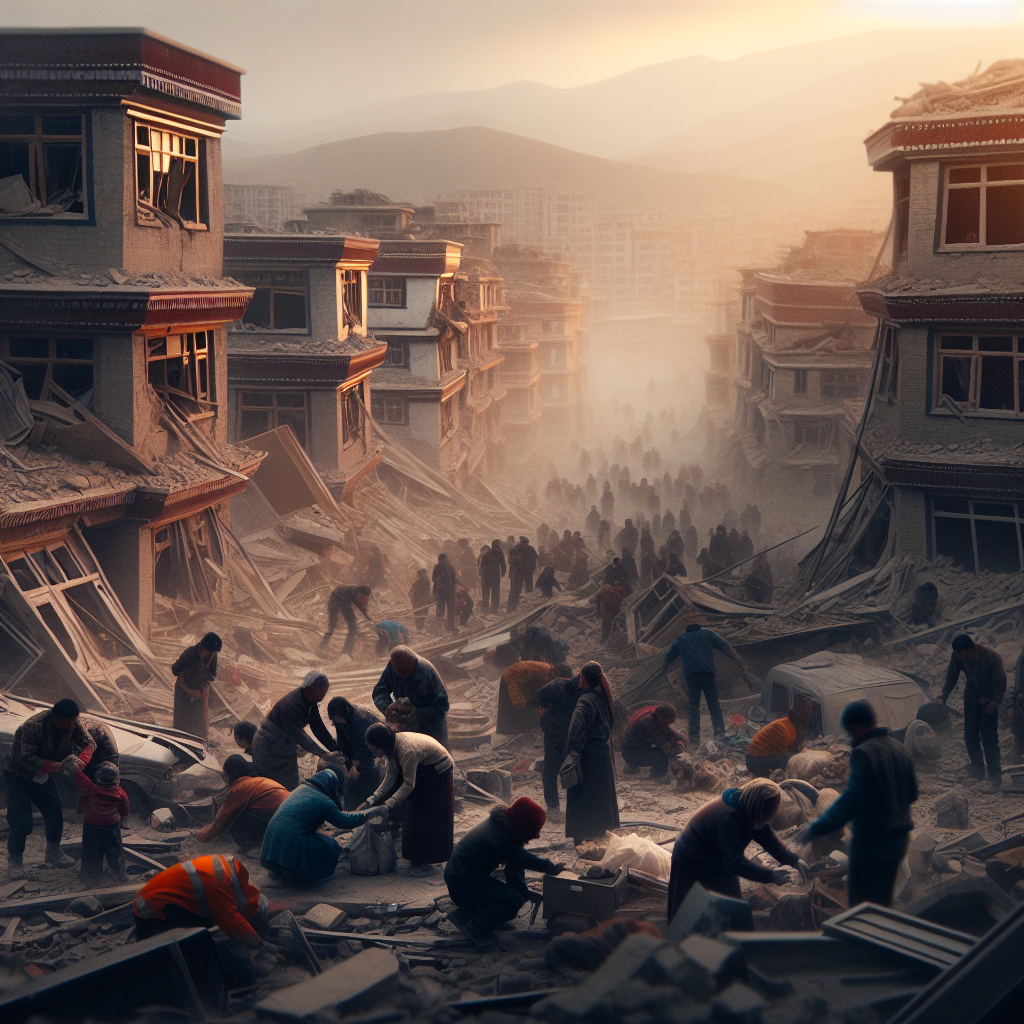On the morning of January 7, a strong earthquake measuring 6.8 magnitude struck Dingri County in Shigatse City, Tibet. By 7 PM on the same day, official reports indicated that 126 people had died and 188 were injured. There have been no further updates on the casualty figures since then. Survivors of the earthquake shared their harrowing experiences of escape and the severe impact of the disaster with reporters.
One such survivor, a man named Qi Hao from Gansu, was in Dingri County for a business trip when the earthquake hit. He was jolted awake by the intense shaking at 9:05 AM while sleeping in a guesthouse. Without fully understanding the situation, he instinctively rushed downstairs from the second floor as items inside the guesthouse were falling all around him amidst the violent tremors. Qi Hao recalled feeling terrified and trembling as he ran downstairs, feeling cold and scared.
In the early hours of the morning when it was still dark in Shigatse City, Qi Hao and his three colleagues made their way outside as they were still half-asleep. He described the chaotic escape, saying, “We didn’t even know how we managed to run downstairs from the stairs; we were not even wearing clothes, just our underwear.” He mentioned reaching the parking lot outside where his entire body trembled, and he witnessed women crying. Fortunately, the guesthouse, being a newly constructed two-story building, did not suffer significant damage.
With the morning temperature hovering around minus 15 degrees Celsius, many people, inadequately dressed, stood on the streets. Qi Hao shivered outside for over half an hour until a brave friend went back to the room to fetch blankets and clothes for them to wear by the roadside.
Qi Hao recounted experiencing three strong tremors, the first one lasting about 30 seconds followed by another lasting over ten seconds. He mentioned continuous aftershocks still occurring at the time of his interview.
He explained that only rescue and official vehicles could travel within Dingri County at the moment, with strict controls already in place even before the earthquake. Some roads were now impassable due to the earthquake damage, making it impossible for them to return home. Qi Hao and a group of about 10 to 20 people took two vehicles, loaded with instant noodles and other food supplies, towards the hardest-hit areas to provide meals for the disaster victims. They arrived in Chuangsuo Township approximately 15 kilometers away from the county by noon on the 7th to offer support.
According to Qi Hao, the most severely affected areas were Cuoguo Township, Quluo Township, and Chuangsuo Township, each housing around seven to eight dozen households, totaling over two thousand people. As they traveled, they witnessed widespread destruction – “90% of the houses were completely collapsed, and 18 people were found dead in front of the township government building,” Qi Hao reported.
He mentioned that according to Tibetan customs, the deceased had been gathered in a tent with oil lamps lit in front of each body, and no photography was allowed. Qi Hao did not venture closer to look but described seeing people with head injuries, crying children, and bodies being carried out. He expressed that it was evident that many were still trapped underneath the collapsed buildings, given that most villagers were asleep at home when the earthquake struck. While official reports estimated over a hundred casualties, Qi Hao believed the death toll would increase, though there had been no further updates on the 8th.
He recalled distributing food to the disaster-stricken residents along the way and reaching Chuangsuo Township where almost all the supplies from the two vehicles had been distributed. Setting up tents across from the township government, they worked tirelessly until 8 PM that day to ensure all the food had been distributed before returning to the county, planning another support mission to the hardest-hit areas the following day.
Describing the dire poverty of the rural residents, Qi Hao expressed concern that relief supplies had yet to reach them on the first day, leaving the survivors suffering in the cold weather. He hoped that aid from various places would promptly reach those in need.
Attributing the severe casualties to the construction of brick houses without reinforced structures in rural areas, Qi Hao and his colleagues reflected on the precariousness of their escape and how close they had come to death had their hotel collapsed.
According to the United States Geological Survey (USGS), the earthquake measured 7.1 magnitude with a depth of 10 kilometers, classifying it as a shallow earthquake. However, the official Chinese earthquake report listed the magnitude as 6.8.
The earthquake’s epicenter was located approximately 75 kilometers northeast of Mount Everest. The region experiences frequent geological activity due to the collision between the Indian plate and the Eurasian plate, leading to the uplift of the Himalayas, which can even affect the heights of some of the world’s tallest peaks.

